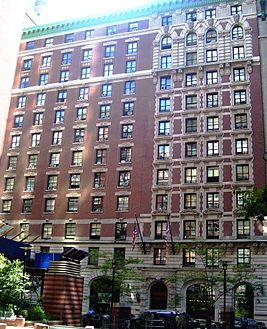- Howard Greenley
-
 The exterior of the former Prince George Hotel, designed by Greenley, now being used by the charity Common Ground to house at-risk and homeless persons.
The exterior of the former Prince George Hotel, designed by Greenley, now being used by the charity Common Ground to house at-risk and homeless persons.
Howard Greenley (1874–1963) was an architect who worked from the late 1800s well into the 20th century and known mainly for his work in New York City, Long Island, and Newport, Rhode Island. Greenley was a prominent figure in the architectural world in his time, having trained initially in the office of Carrere and Hastings and then at the Ecole des Beaux-Arts in Paris. Greenley served as the president of the Architectural League of New York for a quarter of a century, and was one of the featured architects in the book Long Island Country Houses And Their Architects 1860 to 1940 by Robert Mackay and Brendan Gill.
Contents
Buildings
Prince George Hotel
At 14 stories tall, the Prince George Hotel at 14 East 28th Street, was one of the New York's largest early 20th century hotels. It was constructed in two phases, with the main building going up in 1904 and a northern wing added in 1912. The exterior of the hotel has a Beaux-Arts character, with a rusticated limestone base, red brick and white terra-cotta trim above, and three-dimensional sculptural ornaments. Its ground floor included the Lady's Tearoom, the English Tap Room, and the Hunt Room. One of the centerpieces of the original building is The Ladies’ Tea Room, with its trellised piers and arches, Rook wood faience fountain, lighting set within opalescent glass cartouches, and murals by George Inness, Jr.
The Ballroom at the Prince George is part of the Madison Square North Historic District and listed on the National Register of Historic Places. Designed by Greenley, the ornate ballroom featured Renaissance-inspired murals and reproductions of famous paintings, along with intricate woodwork, marble mosaic floors, ceiling murals, and elaborate carvings. It features neo-Renaissance details, including plasterwork garlands, cherubs, and acanthus leaves. Columns details include cherubim, fruit garlands and faces with leafy walrus mustaches. The room also has herringbone oak floors, and a marble mantelpiece. 18-foot coffered ceilings are heavily ornamented. Its columns are encrusted with plump cherubim, ripe fruit garlands and faces with leafy walrus mustaches.
The hotel continued to function, though in decline, through the 1980s, when, suffering from a decline in tourism and an increase in homelessness in the area, it began to contract with the city to house homeless families, with the ballroom serving as a multi-function space: dining room, offices, and basketball court. As it continued to decline, writer Jonathan Kozol called it "one of the grimmest places I've ever been." The city shut down the hotel in 1989, and it was purchased by Common Ground, a social services organization, in 1996.[1]
In 1998, renovation of the building began, funded by Federal and state funds and private grants, under the control of Beyer Blinder Belle, who had also overseen the renovation of Grand Central Station. The building re-opened in 1999.[1] The Ballroom was renovated later, in 2004.
SeaView Terrace
 The Carey Mansion, originally called SeaView Terrace, in 1999
The Carey Mansion, originally called SeaView Terrace, in 1999
The American League of Architects awarded Greenley their President's Medal in 1928 for the design of SeaView Terrace, Mr. and Mrs. Edson Bradley's sprawling French Renaissance manor house, one of the last of the immense Gilded Age Newport summer palaces to be built. The house was conceived in 1924 and built between 1927 and 1929, incorporating an existing Elizabethan residence known as Seaview (1885) formerly owned by James Kernochan. In keeping with its seaside location, the 65-room manor house features turrets, stained-glass windows, high, arching doorways and shell motifs that adorn the facade. Rooms imported intact from France were moved from the Bradley home in Washington, D.C. to Newport, and reassembled with the chateau constructed around them.
The house was used as an all-girls summer boarding school, "Burnham-by-the-Sea", beginning in 1950. From 1966 to 1971, the television show Dark Shadows used the exterior as the outdoor set for the fictional Collinwood Mansion. More recently, part of the main house and some of the outbuildings were used by Salve Regina University. The house has now been returned to private use, and is known as the Carey Mansion.
Corning Free Academy
Corning Free Academy in Corning, New York was built as a school in 1922 in the classical Romanesque Revival style. It features elaborate terra cotta, which was produced locally by the Corning Brick and Terra Cotta and Tile Company. A sculptured relief above the main entrance was designed by the New York sculptor Leo Lentelli. Decorative Aurene glass shades were produced by Corning Glass works under the direction of Frederick Carder, a prominent glass designer, member of the community, and president of the Board of Education. The clocks on the central bell tower have been put back in working order recently and the 1873 bell, manufactured in West Troy, New York continues to ring. Stone and iron work from the Amory A. Houghton house one block away were incorporated into the construction of the school.
References
- Notes
- ^ a b Castagnaro, Kelly. "An Elegant Old Hotel Gives new Lives to Homeless". Gotham Gazette (September 21, 2005)
Categories:- American architects
- 1874 births
- 1963 deaths
Wikimedia Foundation. 2010.
